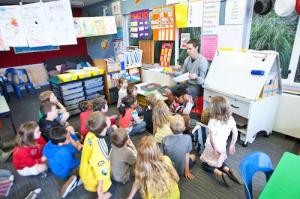School entrants can speak a language and need to learn to read and write it. They need to work out how every aspect of their spoken language relates to messages in print.
Clay, 2013, page 116
Oral language underpins all literacy learning. From their earliest interactions with others, children learn the importance of language for communication. As they become more proficient users of language, children come to understand that speech is made up of a sequence of sounds. Many children develop the ability to hear the different sounds within words easily with little direct teaching, but some need specific and focussed instruction.
As children’s proficiency in spoken English develops, they learn how to modify regular verbs to indicate actions occurring in the past (“he looked”) or in the present (“she looks” or “she is looking”). They come to understand that someone who teaches is a “teacher” and that when they are comparing things, they can use words such as “bigger” or “longer”. They also learn to add “s” to nouns to denote plurals.
A classroom environment that encourages an interest in and enjoyment of language supports all aspects of literacy learning. A classroom rich in poetry, songs, wordplays, drama, books, language games, and lively, purposeful talk builds students’ appreciation and awareness of language and establishes a meaningful context for instruction in the sound structure (phonology) of the English language. (Learning through Talk, pages 19 and 71, adapted).
Poetry and songs, jingles and rhymes, and inventing words in play are activities that break utterances and words into parts and make words from parts. Together with slow articulation of some words in writing and reading, these activities can result in significant gains …
Clay, 2014, page 54



